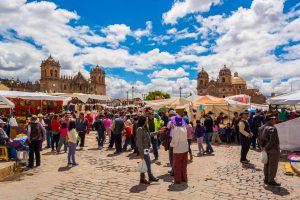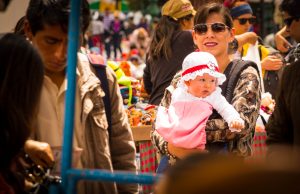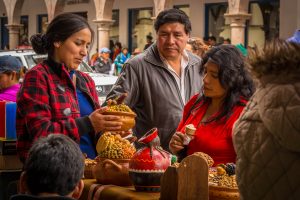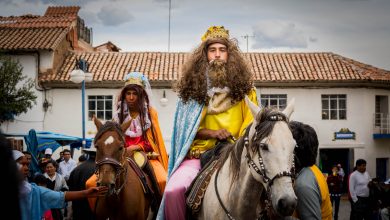A Christmas Market (Santurantikuy) fills Cuzco’s Plaza Today

Thick clouds stipple the sky, heavy with moisture. From above Cuzco’s Plaza de Armas also looks to have filled with clouds, only under these you will find row after row of handicrafts. This is Santurantikuy, whose name means “to buy a saint” referring to the Niño Manuelito, the Christ Child.
It is still early, but in a short while it will fill with the people of Cuzco who will stroll through the aisles of hand work, under rectangles of white. The highlights are the fine work which are part of the municipal competition, often by known master artisans. The best will be bought by the Municipal agency responsible for organizing fiestas and celebration to be kept in the municipal collection and shown in museums.

Though the Christmas market has a great diversity of handicrafts, different from that you see daily in the tourist markets, it also has representations of local life—such as portrayals of picanterías, popular restaurants, with colorful names, such as “butt slapper” (siki takana) after a well-known picantería in Santa Ana where the streets are steep and people often fall and smack their bottoms.
The star of the event, however, is the Christ Child in his diverse representations in a wide variety of materials and styles along with all that people need to dress him and put together their manger scenes in their homes. You see moss, grass, branches, miniature bushes and trees, as well as stables, and a diversity of animals.
After buying a Niño Emanuel, a Christ Child, it is the custom to take him to mass to be blessed and to enter into communication with the holy figures held within, especially in the Cathedral. Lines of people with their Christ Child in their arms or on their lap will soon appear. People will place the Baby Jesus on the steps of the main altar, each more well dressed than the last, as if a competition to see who has the best dressed child.


At midnight, people will place the Niño in a manger within the often very large and involved scenes they have spent hours putting together. The nascimientos, as they are called, often occupy a corner of one of the family’s rooms or even a larger space.
Besides bringing the story of Christianity into the home, the manger scene also brings the holy power of creation and good fortune into the family. Some people will even apply to it the Andean custom of looking at the scene for auguries to ascertain the family’s future. It also fits into the tradition in which there was a child that was the first representation of the son, the great deity of the Incas. As a result, when the Spanish came many of the Inca elite took the Christ as their own and organized themselves into confraternities celebrating the Christ Child. The image of Manuelito, Emanuel, carries these historical ties.
At the shrine of Qoyllur Rit’i , where the people of Cuzco will travel right before the feast of Corpus Christi, on the rock is an image of Christ. Its Saint’s story tells of a child of light and gold who came to play with a boy who was herding sheep.The child brought abundance and good luck to the boy. Later the shepherd’s family and community found out that the shining child was the Christ Child. In his shining he was also associated with the light of the son, the stars, and especially the glacier there.

Pilgrims come from far and wide to pay homage to the Christ of the shining snow there and to “play” in order to obtain good fortune and abundance.
Today’s market, which is an old custom for this date in Cuzco, follow in this tradition. People come to see and buy the Niño Manuelito, or Christ Child, created by their craftsmen and artisans. At the same time, they see representations of place—Cusco—and its culture and folk environment, as well as many things which can contribute to good fortune and abundance in their homes.
At midday, traditional Cuzco Christmas carols, called villancicos, will be performed in the plaza.
Here you can see a music video of a popular Cuzco villancico, “Ch’aska Ñawi Niñucha” (Starry-Eyed Much-Loved Child). Here is another take on the same song.














